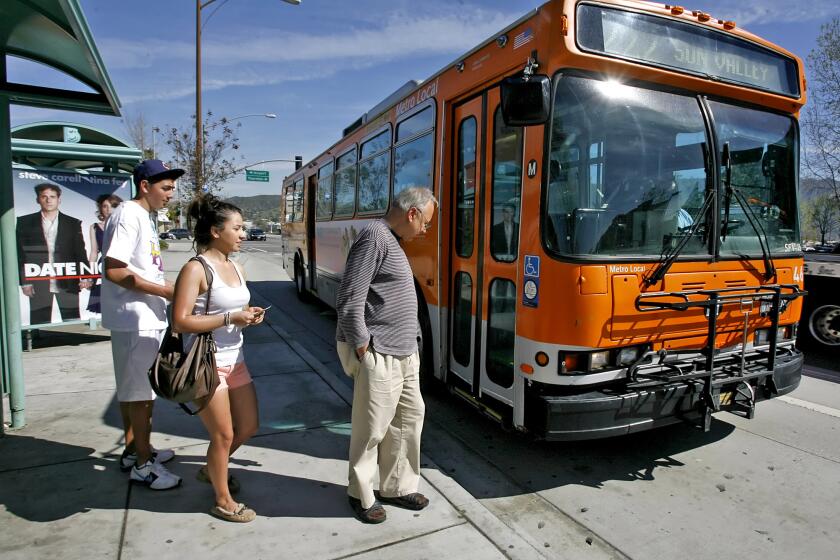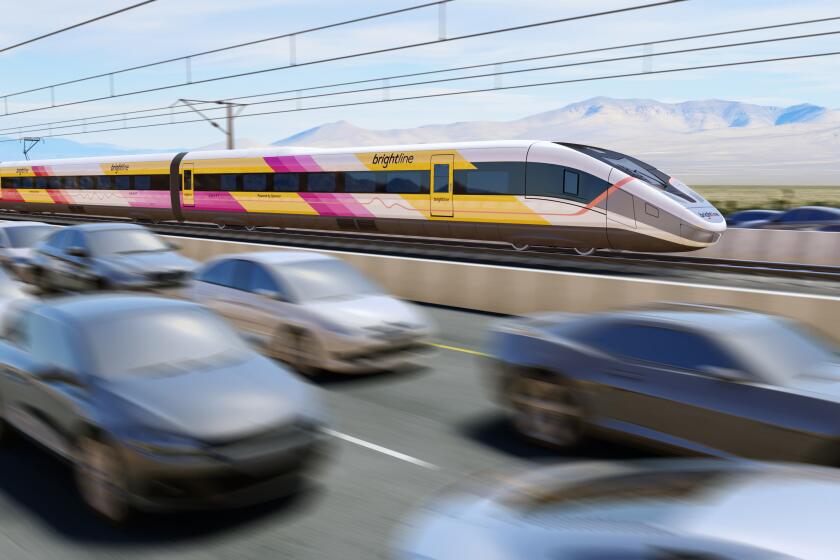Air Quality District Hoping 800 Number Will Help CUT-SMOG
Don’t you just hate it when somebody blows smoke in your face?
I’m not talking about cigarette smoke.
I’m talking about that black, smelly, sooty plume aimed directly at you when you’re stuck behind a truck, bus or car.
What can you do about it? You can’t very well hold your breath until you get where you’re going. And even if you did have a bumper sticker proclaiming, “I mind very much if you smoke,” the guy driving the offending vehicle can’t just switch off the fumes and keep going, even if he wants to.
But now, thanks to the South Coast Air Quality Management District, there is something you can do. It won’t solve your immediate problem--you’ll need a gas mask for that--but it might make you feel less frustrated. And you’ll be helping clear the air, if only in a small way.
You can rat on him. Turn him in, squeal, notify the authorities, become an informer, turn stool pigeon, sing like a canary, dabble in law enforcement, become an air quality vigilante.
Next time you see a vehicle fouling the air, pick up the phone and call (800) CUT-SMOG. Operators are standing by 24 hours a day, and you don’t even need to have your MasterCard or Visa handy.
But wait! Don’t pick up the receiver just yet, not until you’ve written down the offender’s license number, the make of the car, truck or bus, and the date, time and place you saw the smoke.
With that information, the AQMD can send a warning letter to the vehicle’s registered owner, urging him to hurry to a mechanic and have the problem solved. The letter carries no official clout, but it looks impressive enough that some recipients have gone so far as to mail copies of their repair bills to the AQMD, said Jacqueline Switzer, a spokeswoman for the district.
“People have written and thanked us for causing them to go ahead and get their car repaired. And a couple of truck drivers have thanked us for forcing the vehicle owners to clean them up,” she said.
Before calling, Switzer said, drivers should count to 10--to make sure the emission lasts for at least 10 seconds. “If a diesel truck changes gears on the on-ramp and emits a puff of smoke, that doesn’t count,” she said.
The CUT-SMOG hot line has been in operation since June 1 as part of a three-pronged program designed to increase public awareness about vehicles with excessive exhaust.
The California Highway Patrol now has eight officers whose sole duty is to look for and cite smoking vehicles, Switzer said. Two of those officers patrol Orange County. The program also has five inspectors on the lookout for smoking buses.
In the first two months, the hot line received more than 13,000 calls. Unfortunately, only about half of them led to letters, Switzer said, because “a lot of people are not providing us with complete and correct information. Somebody will call and tell us they saw a red Honda Prelude with license number such-and-such, and when we check with the DMV (Department of Motor Vehicles), the number doesn’t match up. Or sometimes they won’t give us a license number at all.
“Some people just call and say, ‘Wow, I just saw this car on the freeway, and it was really smoking like a bomb.’ Well, there isn’t much we can do about it without (more complete) information.”
The district wants specific information about the offending vehicle, but they don’t have to know anything about you. “If you want, you can give them your name,” Switzer said. “But you can do the whole thing anonymously.”
To encourage calls, the AQMD is distributing 50,000 “(800) CUT-SMOG” buttons. Switzer said district officials hope car-phone owners in particular will call in.
Vehicle exhaust accounts for almost all of the pollutants in the South Coast Air Basin, Switzer said.
“The primary problems are fine particulates--basically, soot--from hydrocarbons when the fuel is not completely burned. They can get down into your lungs and can really hamper your lung function, particularly if you have an illness such as emphysema or even a cold,” she said.
“Then there’s carbon monoxide. And in sunlight, the hydrocarbons form nitrogen oxide. That’s what causes the air to turn brown.”
Switzer said 8% of lung cancers among urban nonsmokers is attributable to motor vehicle exhaust.
The district has an ulterior motive in encouraging people to turn in their fellow drivers. “We want to raise people’s awareness, and we hope that maybe they’ll take a presumptive step and have their vehicles checked out.”
Most of us are already familiar with the every-two-years mandatory smog check program. But diesel owners aren’t subject to those regulations, and some of them may assume they don’t have to worry about emissions.
“We think that’s something that ought to be changed,” Switzer said. “But the Vehicle Code has always allowed the CHP to cite diesel vehicles.”
Government-owned vehicles aren’t immune, either. She said some callers have reported transit district buses, and in those cases the procedure was exactly the same.
“It isn’t really much the larger transit districts--they tend to have really good maintenance. The real problems seem to be with the smaller companies, like the Las Vegas turnaround buses, that make long trips back and forth across the desert and may not have the best maintenance.”
Even school buses have been turned in, she said. “A lot of school districts just don’t have the bucks to take care of problems like this. But when we inform them, we do get excellent cooperation.”
To Pass the Time
Reading the newspaper, painting nails, playing chess, playing a musical instrument--Orange County drivers do some strange things when they’re stuck in traffic, or even when they’re moving at 55 or faster. What’s the weirdest thing you’ve ever seen a fellow driver do on the freeway? And fess up: What’s the oddest thing you’ve ever done?
Attention, Non-Drivers!
Is it possible to live without a car here? If you’re totally or mostly dependent on alternative means of transportation, such as bicycles or buses, tell us how you get along, and around, without a car.
More to Read
Start your day right
Sign up for Essential California for news, features and recommendations from the L.A. Times and beyond in your inbox six days a week.
You may occasionally receive promotional content from the Los Angeles Times.






